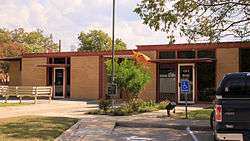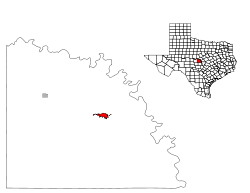San Saba, Texas
San Saba is a city located in, and the county seat of, San Saba County, Texas, United States.[5] It was settled in 1854 and named for its location on the San Saba River.[6] The population was 3,099 at the 2010 census.
San Saba, Texas | |
|---|---|
 San Saba City Hall | |
| Motto(s): "The Pecan Capital of the World" | |
Location of San Saba, Texas | |
 | |
| Coordinates: 31°11′43″N 98°43′30″W | |
| Country | United States |
| State | Texas |
| County | San Saba |
| Area | |
| • Total | 2.71 sq mi (7.02 km2) |
| • Land | 2.71 sq mi (7.02 km2) |
| • Water | 0.00 sq mi (0.00 km2) |
| Elevation | 1,204 ft (367 m) |
| Population (2010) | |
| • Total | 3,099 |
| • Estimate (2019)[2] | 3,168 |
| • Density | 1,169.44/sq mi (451.47/km2) |
| Time zone | UTC-6 (Central (CST)) |
| • Summer (DST) | UTC-5 (CDT) |
| ZIP code | 76877 |
| Area code(s) | 325 |
| FIPS code | 48-65648[3] |
| GNIS feature ID | 1367538[4] |
| Website | City of San Saba, Texas |
Geography
San Saba is located at 31°11′43″N 98°43′30″W (31.195298, -98.725003).[7] According to the United States Census Bureau, the city has a total area of 1.8 square miles (4.7 km2), all of it land. The city is located 105 miles northwest of Austin,[8] and 141 miles north of San Antonio.[8]
Climate
The climate in this area is characterized by hot, humid summers and generally mild to cool winters. According to the Köppen climate classification system, San Saba has a humid subtropical climate, Cfa on climate maps.[9]
Demographics
| Historical population | |||
|---|---|---|---|
| Census | Pop. | %± | |
| 1860 | 111 | — | |
| 1870 | 168 | 51.4% | |
| 1880 | 598 | 256.0% | |
| 1890 | 697 | 16.6% | |
| 1920 | 2,011 | — | |
| 1930 | 2,240 | 11.4% | |
| 1940 | 2,927 | 30.7% | |
| 1950 | 3,400 | 16.2% | |
| 1960 | 2,728 | −19.8% | |
| 1970 | 2,555 | −6.3% | |
| 1980 | 2,850 | 11.5% | |
| 1990 | 2,626 | −7.9% | |
| 2000 | 2,637 | 0.4% | |
| 2010 | 3,099 | 17.5% | |
| Est. 2019 | 3,168 | [2] | 2.2% |
| U.S. Decennial Census[10] | |||
As of the census[3] of 2010, 3,099 people, 1,008 households, and 680 families resided in the city. The population density was 1,468.6 people per square mile (565.6/km2). There were 1,177 housing units at an average density of 655.5 per square mile (252.5/km2). The racial makeup of the city was 78.54% White, 0.64% African American, 1.74% Native American, 0.11% Asian, 17.33% from other races, and 1.63% from two or more races. Hispanic or Latino of any race were 31.51% of the population.
Of 1,008 households, 30.9% had children under the age of 18 living with them, 52.2% were married couples living together, 11.8% had a female householder with no husband present, and 32.5% were not families. About 30.9% of all households were made up of individuals and 18.7% had someone living alone who was 65 years of age or older. The average household size was 2.50 and the average family size was 3.12.
The population was distributed as 27.0% under the age of 18, 6.5% from 18 to 24, 23.7% from 25 to 44, 20.1% from 45 to 64, and 22.7% who were 65 years of age or older. The median age was 39 years. For every 100 females, there were 82.4 males. For every 100 females age 18 and over, there were 79.2 males.
The median income for a household in the city was $27,758, and the median income for a family was $31,582. Males had a median income of $24,207 versus $20,216 for females. The per capita income for the city was $14,192. About 16.0% of families and 19.6% of the population were below the poverty line, including 29.9% of those under age 18 and 12.1% of those age 65 or over.
Economy
Pecans emerged as an important crop, largely because of the work of Edmund E. Risien, an Englishman who moved to San Saba County in 1874 and made improvement of the native nuts his life's work. Risien founded the West Texas Pecan Nursery at the junction of the San Saba and Colorado Rivers. The "Mother Pecan Tree", located in the heart of this orchard, has been used to produce many great pecan varieties. Some of these include the San Saba Improved, Texas Prolific, Onliwon, Squirrel Delight, No.60 and Western Schley, and these are just a few of the varieties this tree has produced.
During his era, Risien's customer base included Queen Victoria of England, Alfred Lord Tennyson and the Post Cereals. Today, Risien is credited for laying the groundwork for the pecan industry that led San Saba County to proclaim itself 'Pecan Capital of the World'.[11] Today the land and orchard is owned by the Millican family and six generations have worked in the pecan business.[12]
Education
The City of San Saba is served by the San Saba Independent School District. Its schools include San Saba Elementary, serving students in grades K-4; San Saba Middle School, serving grades 5-8; and San Saba High School, grades 9-12. The school district opened two new facilities in October 2013, a new elementary building that houses all elementary grades under one roof for the first time in many years, and a new set of science labs in a building immediately across from the main entrance to the high school, named for science teacher George Dennis, who was on the faculty for over 50 years until his retirement in December 2012. The current superintendent of schools is Michael Bohensky, and the individual campuses are headed by Kay Shackelford (elementary), Dustin Anders (middle school), and Scott Snyder (high school).
Notable people
San Saba is the birthplace of actor Tommy Lee Jones, geologist M. King Hubbert, opera singer Thomas Stewart, Aaron Behrens, front man for Austin-based music group Ghostland Observatory.
In the movie "Red River" (1948) with John Wayne, the cattle drive stops at San Saba for water and rest.
In popular culture
In "The San Saba Incident" (October 18, 1957) of the CBS Western television series Trackdown starring Robert Culp as Texas Ranger Hoby Gilman, the Ranger transports four prisoners to the Texas State Penitentiary at Huntsville. One of the convicts is a woman, Abby Lindon, played by Margaret Hayes.[13]
In the 2010 remake of True Grit, Rooster Cogburn (played by Jeff Bridges) tells Mattie that they will take the criminal to the magistrate in San Saba, Texas.[14][15]
In Cormac McCarthy's book No Country for Old Men, the main character, Llewellyn Moss, states he is from San Saba, Texas. Coincidentally, Tommy Lee Jones, the actor who plays Sheriff Bell in the movie version is also from San Saba.
In Robert Fulghum's book All I Really Need to Know I Learned in Kindergarten one of short stories is set in San Saba.
In the song "Tumbleweed Stew", Slaid Cleaves' character states that "he works as a hand in San Saba."
In the 2018 Coen brothers film The Ballad of Buster Scruggs, the title character is known as the "San Saba Songbird."
In the 2019 movie The Highwaymen, former Texas Rangers Frank Hamer (Kevin Costner) and Maney Gault (Woody Harrelson) join forces to try and capture notorious outlaws Bonnie Parker and Clyde Barrow. Frank Hamer tells a childhood story, stating he is from San Saba.
References
- "2019 U.S. Gazetteer Files". United States Census Bureau. Retrieved August 7, 2020.
- "Population and Housing Unit Estimates". United States Census Bureau. May 24, 2020. Retrieved May 27, 2020.
- "U.S. Census website". United States Census Bureau. Retrieved January 31, 2008.
- "US Board on Geographic Names". United States Geological Survey. October 25, 2007. Retrieved January 31, 2008.
- "Find a County". National Association of Counties. Retrieved June 7, 2011.
- City of San Saba History Archived May 5, 2011, at the Wayback Machine
- "US Gazetteer files: 2010, 2000, and 1990". United States Census Bureau. February 12, 2011. Retrieved April 23, 2011.
- Climate Summary for San Saba, Texas
- "Census of Population and Housing". Census.gov. Retrieved June 4, 2015.
- Turner, Matt Warnock; Koch, K (2009). Remarkable Plants of Texas: Uncommon Accounts of Our Common Natives. University of Texas Press. pp. 11–17. ISBN 978-0-292-71851-7.
- http://www.millicanpecan.com
- Billy Hathorn, "Roy Bean, Temple Houston, Bill Longley, Ranald Mackenzie, Buffalo Bill, Jr., and the Texas Rangers: Depictions of West Texans in Series Television, 1955 to 1967", West Texas Historical Review, Vol. 89 (2013), pp. 105-106
- Coen, Ethan; Coen, Joel (December 22, 2010), True Grit, retrieved October 7, 2016
- "True Grit Script at IMSDb". www.imsdb.com. Retrieved October 7, 2016.
External links
| Wikimedia Commons has media related to San Saba, Texas. |

